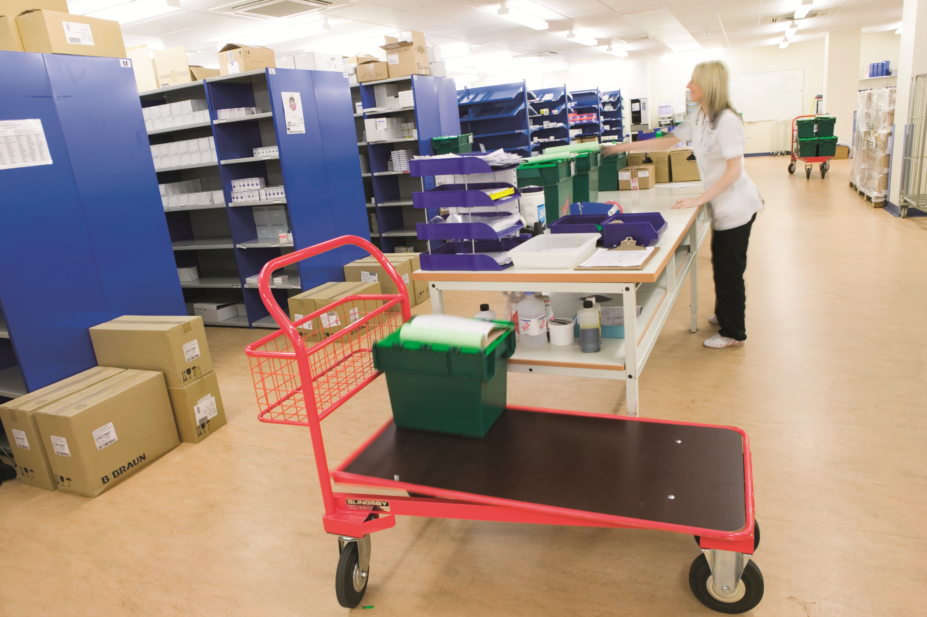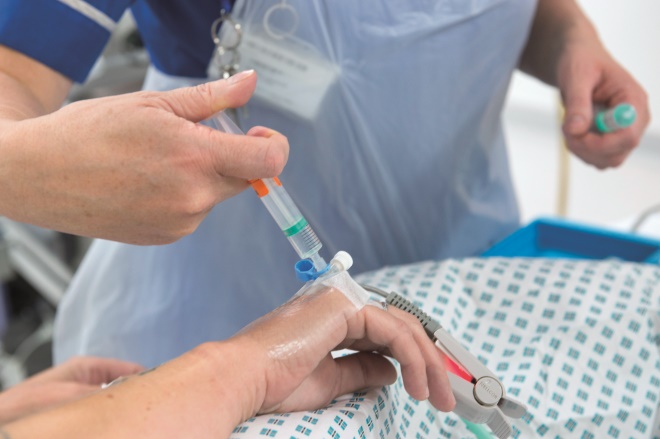
Science Photo Library
In 2017, an explosion at a Chinese antibiotics factory caused a major headache for healthcare systems around the globe.
The factory was the only producer of the main active ingredient needed to make piperacillin-tazobactam (Tazocin; Pfizer), a commonly used antibiotic for life-threatening infections such as pneumonia, appendicitis and septicaemia.
The sudden shortage of such an important antibiotic left the UK health service scrambling. Hospitals were told to reserve piperacillin-tazobactam only for the most severe cases and rip up their antibiotic conservation plans to use alternatives. The government was even forced to release a limited supply of cefuroxime and co-amoxiclav injections that were held in a central stockpile for emergencies and pandemics.
Thankfully, there were no reports of patient care being affected, but this kind of incident is very likely to happen again, according to a report from the not-for-profit Access to Medicines Foundation (AMF)[1]
.
The AMF says the global anti-infectives market is “patchy, complex and at risk of collapsing” with the scarcity of active pharmaceutical ingredients a major factor (see Box 1). For some key antibiotics, the failure or exit of just one factory or manufacturer could cause the entire supply chain to disintegrate.
For instance, at the moment there are shortages of benzathine penicillin G reported in 39 countries (not yet including the UK), which is putting millions of lives at risk. The AMF warns the route of the problem is that its supply chain is reliant on only four manufacturers of the active pharmaceutical ingredient and there are many other antibiotics in a similar position (see Box 1).
The report highlights that, when shortages occur, doctors often resort to using less optimal treatments that are not only less effective but increase the risk of antimicrobial resistance (AMR). “Every time we use an antibiotic we give bacteria the chance to adapt and develop resistance. To reduce the threat of AMR, doctors must ensure that the right antibiotic is used against the right organism,” the paper says.
Worsening problem
After the piperacillin-tazobactam incident, there are ongoing high-level talks between industry and the UK government about how to prevent a repeat. But pharmacists say supply problems are getting worse — and are proving costly.
Conor Jamieson, pharmacy team leader for antimicrobial therapy at Sandwell and West Birmingham NHS Trust, says: “The shortage of piperacillin-tazobactam caused real problems for us, and we had to revise a number of guidelines that recommended it empirically.”
Box 1: Antibiotics at risk of shortages
- Piperacillin-tazobactam
- Ampicillin-sulbactam
- Meropenem
- Cefotaxime
- Cefepime
- Benzathine penicillin G
- Gentamicin
- Trimethoprim/sulfamethoxazole
Source:
Access to Medicines Foundation 2018, personal communications from UK hospital pharmacists
Jamieson adds: “Recently it was clindamycin 600mg injection; I remember a time [in 2017] when I was emailing the microbiologists to say there could be problems with co-amoxiclav and ciprofloxacin injections as well — they were horrified, luckily it didn’t come to pass.

Source: Courtesy, Conor Jamieson
Conor Jamieson, pharmacy team leader for antimicrobial therapy at Sandwell and West Birmingham NHS Trust, explains how the shortage of piperacillin-tazobactam caused his pharmacy team to revise numerous guidelines that recommended the medicine
“Shortages have big financial consequences for us; we are buying unlicensed co-trimoxazole injection, which is another cost pressure. The shortage of metronidazole suppositories has led us to have to revise our guidance for surgical prophylaxis for [transrectal ultrasound guided] biopsy.”
We had to change to using a combination of antibiotics for the treatment of hospital-acquired pneumonia, which led to a large increase in our antibiotic consumption
NHS England has given hospitals tough targets in 2018 to cut the use of antibiotics that fall into the ‘access’ group of the World Health Organization (WHO) AWaRe list — which categorises drugs by how commonly they should be used in order to avoid resistance problems — through the Commissioning for Quality and Innovation (CQUIN) contract. Hospital trusts also have targets for cutting the use of carbapenem antibiotics in favour of narrow-spectrum options that carry less risk of antibiotic resistance, as is recommended in national guidance on combating Clostridium difficile.
But shortages of antibiotics are having a major impact on trusts’ ability to deliver these targets. “We had to change to using a combination of antibiotics for the treatment of hospital-acquired pneumonia, which led to a large increase in our antibiotic consumption and contributed to us failing our CQUIN target for total antibiotic consumption,” says Jamieson.
“We were also forced to use more meropenem and ertapenem to treat the moderately resistant organisms we regularly see, so our consumption of those also increased and we failed our carbapenem CQUIN target as well.”
He adds: “I know of another trust which is looking to switch their antibiotic guidelines from ultra-broad spectrum for certain indications to a more appropriate narrow spectrum agent, but is unable to do so because supplies of the narrower agent are currently being rationed.”

Source: Science Photo Library
The NHS procurement system is not a straightforward one, as individual trusts manage their stocks of medicines, partially overseen by regional procurement leads
Dealing with shortages
The NHS procurement system is not a straightforward one and different trusts potentially do things very differently. Individual trusts are responsible for planning for their own medicines needs and sorting out stocks and ordering, but there are regional procurement leads who oversee some of the strategy and guidance, as well as dealing with some contract issues for the purposes of economies of scale. In the case of the national piperacillin-tazobactam shortages, the Department of Health and Social Care (DHSC) and the Commercial Medicines Unit stepped in to secure stocks and issue guidance on alternatives.
Guidance to hospital trusts from NHS England on meeting the CQUIN targets points out there had been “numerous antibiotic shortages over the past year” but that the advice had been to “use alternative narrow-spectrum agents and not to automatically switch to meropenem”[2],[3]
. NHS England says it will be monitoring the impact of antibiotic shortages on the CQUIN performance “as shortages occur”. But it says that most trusts have still been able to “reduce both their total antibiotic and meropenem consumption during this challenging period”.
However, data published by Public Health England on antimicrobial resistance indicators suggest that over the past year, the use of carbapenems per 1,000 admissions has started to creep up. For England as a whole, the rate was 99.4 per 1,000 admissions in the final 3 months of 2017 compared with 96.7 per 1,000 admissions at the start of the year. Figures for teaching hospitals show an even greater rise from 114.5 to 126.2 per 1,000 admissions over the same period.
Every week we are having to deal with a mini supply crisis, which takes us away from our quality improvement role and our antibiotic stewardship role
Kieran Hand, consultant pharmacist with responsibility for anti-infectives at Southampton NHS Foundation Trust, says having to constantly source alternative antibiotics owing to product shortages is a “pernicious drain on time and resources”. He says: “Pretty much every week we are having to deal with a mini supply crisis which takes us away from our quality improvement role and our antibiotic stewardship role.”

Source: Courtesy, Kieran Hand
Kieran Hand, consultant pharmacist with responsibility for anti-infectives at Southampton NHS Foundation Trust, says having to source alternative antibiotics because of ongoing product shortages hinders the pharmacy’s quality improvement
Hand, who was on the strategy group advising the DHSC on alternative antibiotics and new guidelines during the piperacillin-tazobactam shortages, says the government coped well in 2017, but adds: “Something we hadn’t anticipated is that companies plan for an expected demand of certain drugs, so if you have a drug that is used very extensively like pip-taz and you suddenly divert to other choices, companies don’t have the quota. Then you begin to run into supply problems with the contingency drugs that you need to fill the gap.”
He believes there are two lessons that the UK can learn from the shortages around both procurement and guidelines. “The first is the need to award national contracts to two or three suppliers rather than relying on one. And the second is for guidelines to offer a range of antibiotic options for prescribers to choose from. We need to encourage diversity in prescribing and offering some flexibility means you don’t have to completely rewrite the guidelines each time — just go for another on the list.”
Stephen Hughes, antimicrobial pharmacist at Chelsea and Westminster Hospital NHS Foundation Trust, agrees that overreliance on single contracts is a big problem that needs to be addressed. “At the moment when contract number one falls down, contract number two or three tells us to get lost because they are no longer supplying it because it was not financially viable for them. One option would be to have a geographical patchwork so London has a different system from the North West, say.”

Source: Courtesy, Stephen Hughes
Stephen Hughes, antimicrobial pharmacist at Chelsea and Westminster Hospital NHS Foundation Trust, thinks that the problem of increasing costs of antibiotics will worsen after Brexit, as sourcing stock from European markets will no longer be an option readily available
Hughes also says there has been a “healthy spike” in antibacterial drug costs, partly owing to shortages, an issue that could become even more difficult after Brexit when EU options may not be as readily available.
Box 2: How we are preparing for an antibiotic shortage
We are guided by our regional procurement lead for the major shortages such as piperacillin-tazobactam and gentamicin, and the national Commercial Medicines Unit sent out guidance about potential alternatives.
For the more minor shortages, we make do as best we can – in our area, the West Midlands Antibiotic Pharmacists group will often discuss shortages by email or during quarterly regional meetings.
Within the trust, our Antibiotic Management Group will discuss the shortage and any potential impact, amend guidelines if necessary and alert clinical directors, affected physicians, and ward/clinical areas.
If we are very organised, our stores department will send up memos to the wards to remind them if they order the drug that is unavailable; it also goes out on staff communications if it is something that is likely to affect several clinical areas.
Conor Jamieson is pharmacy team leader for antimicrobial therapy at Sandwell and West Birmingham NHS Trust
Global concern
Despite hard work by NHS procurement leads, the problem of antibiotic shortages is a global one and not something that can be easily solved by the UK alone.
The British Association for Antimicrobial Chemotherapy (BSAC) has called for a more robust supply chain for existing antibiotics and, importantly, greater transparency of the supply chain to allow better planning plus larger reserves.
To relieve pressure on individual agents, we need greater access to old antibiotics in all countries to increase antibiotic diversity
Philip Howard, president of BSAC, says the antibiotics listed as essential by the WHO need to be “consistently available”.
He says: “We need a more robust supply chain for existing antibiotics with greater transparency to allow better planning, coupled with larger reserves to cope with failures at any stage of production or distribution. To relieve pressure on individual agents, we need greater access to old antibiotics in all countries to increase antibiotic diversity.

Source: Nadia Attura / RPS
Philip Howard, president of BSAC, believes that a robust supply chain and larger antibiotic reserves along with access to old antibiotics should be paramount in tackling the problem of shortages
“It is also time to take a fresh look at reimbursement models at a global level for generic antibiotics.”
The WHO is in the process of developing a global shortage notification system, which will include all classes of antibiotics. A report on the nature and magnitude of shortages of medicines and vaccines is also due to be published later in 2018. A spokesperson for the agency says: “In a continuation of these efforts, the WHO plans to continue working in 2018 on market assessment for antibiotics and development of workable solutions to address risks to a sustainable supply.
“Also, the WHO is monitoring antibiotic consumption through an annual country reporting mechanism and is working to include reporting on shortages of antibiotics in the system.”
Pfizer, which manufactures piperacillin-tazobactam under the brand name Tazocin, says it is making significant investments in its manufacturing networks and increasing safety stocks to mitigate any future antibiotic shortages.
The DHSC says it is taking steps to address the issues, including working with industry to develop domestic evaluation and reimbursement models that support good antimicrobial stewardship. This includes commissioning a study to help better understand the value of new antimicrobials and exploring the feasibility of delinking company revenues from sales.
The DHSC also says it is studying the Access to Medicines report with interest, and The Pharmaceutical Journal understands that meetings are taking place to try to reduce the risk of this potentially dangerous issue. “We continue to work closely with the pharmaceutical industry and the NHS to make sure appropriate antibiotics are available,” a DHSC spokesperson adds.
References
[1] Access to Medicine Foundation. Shortages, stockouts and scarcity. 31 May 2018. Available at: https://accesstomedicinefoundation.org/media/atmf/Antibiotic-Shortages-Stockouts-and-Scarcity_Access-to-Medicine-Foundation_31-May-2018.pdf (accessed June 2018)
[2] NHS Improvement. Reducing the impact of serious infections CQUIN FAQs, parts 2c and 2d. October 2017. Available at: https://improvement.nhs.uk/documents/1845/CQUIN_FAQs_September_2017_v5_EC.pdf (accessed June 2018)
[3] NHS Improvement. Part 2c and 2d CQUIN 2018/19 webinar, 22 February 2018. Available at: https://improvement.nhs.uk/documents/2615/CQUIN_webinar_questions_and_answers_220218_v6.pdf (accessed June 2018)


